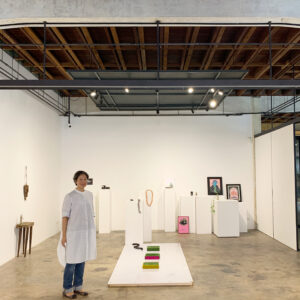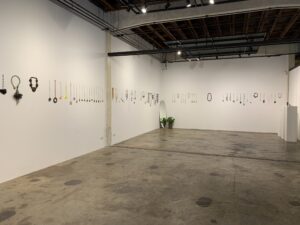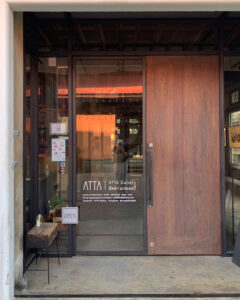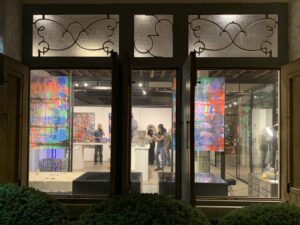Episode 144
What you’ll learn in this episode:
- Why the Thai art jewelry market has been slow to grow but is poised for an explosion
- How Thailand’s tradition of decoration and fine jewelry influences what customers are looking for
- Why Atty wants the artists she showcases at ATTA Gallery to express themselves through their work, without regard for trends
- Why Atty often calls her pieces “wearable art” rather than art jewelry
- How Atty’s background in science helped her become a successful business owner
About Atty Tantivit
Atty Tantivit is a jewelry designer/maker, a gallerist and a creative entrepreneur based in Bangkok, Thailand. In 2010 Atty founded ATTA Gallery, the first and only gallery that specializes in contemporary art jewelry, aka wearable art, in Bangkok, Thailand. Since the opening of the gallery, Atty has played many roles in the field of contemporary art jewelry, both locally and internationally—a gallery director, a curator, an educator, an artist, a writer, a mentor, a collector and an advocate. She has been given an honorable award for being an inspiration and an influencer in the field of jewelry design by a Thai governmental agency and has been invited to share her experience at international symposiums.
Atty had been nominated to be one of the ten most influential creative drivers in Bangkok for the Creative Cities Project 2013, showcased at Kaohsiung Design Festival in Taiwan. She has been an active member of the steering committee for the Creative District movement in Bangrak/Klongsan area of Bangkok.
Atty is passionate about forging sustainable creative and art development in Thailand.
Additional resources:
Photos:
Atty with her art and jewelry collection exhibited at the gallery in How She Collects

Exhibition of necklaces

Front of current gallery with our new logo

Front window looking at current material based art exhibition by local artist

New Gallery Space 1

Transcript:
Atty Tantavit forged a new path for art jewelry when she opened ATTA Gallery, Bangkok’s first and only art jewelry gallery, in 2010. Educating Thai customers on the history, value, and potential of art jewelry has been challenging at times, but Atty is determined to bring attention to this field and support the artists she works with. She joined the Jewelry Journey Podcast to talk about the differences between contemporary jewelry in Thailand, Europe and North America; when she knew it was time to leave her science career for a career in jewelry; and why her customers tend to connect with the term “wearable art” instead of “art jewelry.” Read the episode transcript here.
Sharon: Hello, everyone. Welcome to the Jewelry Journey Podcast. This is a two-part Jewelry Journey Podcast. Please make sure you subscribe so you can hear part two as soon as it comes out later this week.
Today, our guest is Atty Tantivit, founder and owner of ATTA Gallery. The gallery, which was founded in 2010, is Bangkok’s only art jewelry gallery. It’s one of the few in southeast Asia. In addition, Atty has an extensive background as a maker herself. Today, we’ll hear about Atty’s own jewelry journey, both as a maker and a gallerist, and we’ll learn about her expansion plans. Atty, welcome to the program.
Sharon: Hello, everyone. Welcome to the Jewelry Journey Podcast. This is the second part of a two-part episode. Today, my guest is Atty Tantivit, founder and owner of ATTA Gallery. The gallery was founded in 2010 and is Bangkok’s only art jewelry gallery. If you haven’t heard part one, please go to TheJewelryJourney.com.
Welcome back. Tell us about your expansion plans. Do you want to open an art gallery to go with this?
Atty: Last year was kind of tricky—well, not last year, towards the end of 2019.
Sharon: It’s so confusing, right?
Atty: Right. I’d been on vacation for a long time. At the end of 2019, we moved to a new space. It’s a much larger space. We had big plans for what we were doing. We were going to have two art galleries in one space, because I was also running a small gallery for small art pieces. But Covid hit, and my plan had to be rethought. What I also found is that my artists and our clients were confused at the fact that I had two galleries in one place. So, now I have decided to merge the two galleries. We’ll go under the name ATTA Gallery because it’s more established. We will not be focusing just on contemporary jewelry, but we will expand to cover other types of contemporary jewelry as well. Our main focus will still be on material-based art. Craft, arts and jewelry will still be the silver thread running through art curatorial plans.
One thing I found was that positioning contemporary jewelry and promoting contemporary jewelry has its own identity unit. The market was very small. It’s such a niche market that I could not reach the wider audience, but now I’m hoping to be creating dialogues between contemporary jewelry arts and surrounding arts, like photos and paintings, to lift the profile of contemporary jewelry up to the same level as other types of art, because it is art.
Sharon: Definitely, yes. There’s a question I ask; there’s no right or wrong answer, but I’m curious what you see as the difference between art jewelry and contemporary jewelry. Contemporary jewelry can often be fine, as far as I’m concerned.
Atty: I think that’s a tricky one. I remember giving a talk at Zimmerhof back in 2016 and I talked about this, what we call what we are doing. It’s confusing, because when you do a Google search and type in contemporary jewelry—
Sharon: Oh my gosh, yes!
Atty: When you type in art jewelry, a bunch of stuff comes up. Some overlap, some are totally different, and I don’t even how to call it. Sometimes I call it wearable art. That seems to be more easily understood by the local audience, because if they think “jewelry” when they come to the gallery, they won’t see what they were looking for. In Thailand, when they think about jewelry, they think about gemstones. That’s how I thought of it.
So, if they come in and think, “Where are the gems?” we don’t have that, but if they come in and I say, “These are pieces of art that can be worn,” or “They’re wearable art pieces,” they would say, “Ah, O.K.” They’re more accepting with that wording. So, I don’t know. I know that in Europe they call one thing, autonomous jewelry, contemporary jewelry.
Sharon: Yeah, there’s no hard line.
Atty: Also, it’s a problem in that when people search for the kind of jewelry they’re looking for, they don’t know what to call it. We are available, the suppliers are there, the demand is there, but supplies and demands are not matched because we can’t find each other. It’s like we live in parallel worlds in a way.
That is something that’s tricky in finding a new audience. I think the problem with the field—a lot of people talk about it—is that finding a new audience for the field is very hard, right? I think we are relying on 20 to 30 old-school collectors. The field cannot be sustainable that way. We have to find a new audience.
Sharon: Do you still make? Do you still paint? Were you a painter when you did art? I think of painting as an art.
Atty: I haven’t really made anything in quite some time because I had to move my studio out of the old space, so now I don’t have a studio. Without a studio it’s hard to create jewelry pieces, but I do create things with my hands quite often, like stitching, embroidery and little things like that. My passion is still in seeing the creative process, and, to me, the gallery is my creative project. You have to build it up. You have to see how it grows. It’s a big jewelry project in a way.
Sharon: I’m really impressed and amazed. You have taken such a big step of launching a gallery. Did you have to think about it a long time? Do you come from a family of entrepreneurs? How did that work?
Atty: My family’s been very supportive.
Sharon: Oh, that’s great.
Atty: When I decided to switch from science to jewelry, they didn’t object to it; they supported it. When I came back and wanted to open a gallery, they were supportive as well. This is my passion project. I have to tell you the truth: it hasn’t been a profitable business until now. We were on the rise. I have to tell you, Louisa Smith told me that if you want to open a gallery, you have to stick around for least seven, eight years to see the return. You can’t get out before that, and I think that’s very important. If I looked at the numbers in the first few years and if making money was my only goal, I would have closed a long time ago.
Sharon: If making money was your only goal, you probably wouldn’t have opened. I don’t meet many gallerists who don’t love it.
Atty: If people ask, “Are you planning on having the gallery for a long time?” I can’t tell, because right now, I still have passion in it. It intrigues me. I’m so interested in it, and that’s why I’m doing it. But one day if that’s gone, if something else catches my attention, I might as well close. I never know, but at this moment I think I’m still interested in it. There’s still interesting work that I want to show to the world, and I’m hoping I’ll be around for another 10 years at least.
Sharon: It seems like you have a lot of energy and passion left, a reservoir that’s going to last you a long time. Did you name the gallery after you? Why did you pick ATTA Gallery?
Atty: It’s the first two letters from my first name and my last name combined. AT for Atty, then TA. When I put the two together, it turned out to be ATTA. I like the fact that it’s reflective in a way, A-T-T-A, and just by chance there is a meaning in Thai—well, actually in Bali, which is an old Indian language. Atta means “self” or “ego,” and to me, that is something I liked.
When I work with the artist, I want the artist to express who they are through their work, without worrying about trends and whether I’ll be able to sell it. “That sells better, so I want to shift my style into that style.” I don’t want to work with artists like that. I want the artists who are true to themselves and can express themselves to the world and, at the same time, for the audience, for the customers. I want them to come in and look at the pieces, open the drawers and find their own selves through the pieces without saying, “Oh, I saw that actress wearing this piece. Do you have it?” No, because most of the pieces we work with are unique pieces. You find something that is uniquely yours in a way.
I’ve told people that when you come into the gallery, I’m not going to hard sell you, because you have to find your own soulmates. When you open the drawers, today you might not see anything you like. Three months later, you come back in. You might find something you like. Even though you might have seen it three months before, your experiences have changed, and you’ve created stories and meanings and connections with different things at different times. With wearable art pieces or art in general, you can sell to a certain degree, but the audience needs to connect to the pieces.
Sharon: The name and the fact that it means self in Bali is really interesting, because when you wear an art piece, art jewelry is about channeling yourself through it, in a sense.
Atty: We had a slogan, something we put up at the gallery, “Express your thought through contemporary art jewelry.” That’s how we want our clients to feel when they choose a piece of wearable art for themselves.
Sharon: Were you online during the last two years? Is that how you’ve sold the most?
Atty: We have been trying to stay active both onsite and online. We can’t go to fairs. We weren’t able to go to fairs and sell abroad because Thailand has been under self-lockdown in a way. People were still going out, coming to see exhibitions, but we had no tourists, and that was hard for us. Now, it’s better. We had tourists coming in and some bought pieces, so that was great, but we tried to sell online in a way. We promoted things online, art pieces through Instagram, but we don’t have an online shop per se just yet. We’re considering that for the future.
Sharon: It must be a real challenge for everybody to sell their jewelry online, but to sell art jewelry online seems like a real challenge.
Atty: It is, because these pieces need to be tried on most of the time. Unless you’ve tried it on elsewhere already and you haven’t made your decision—that’s a different story. Plus, the price points. Anything above $1,500 U.S. would be harder for people to decide without seeing the actual piece first.
With art jewelry, there are some places where you send the piece over, and they have seven days to look at the piece and return it. It’s not that easy because of the tax and import duties and everything going back and forth. There are costs accruing. It’s not working that way.
Sharon: Hopefully the world will open up more soon. I know we’re facing different variants, but hopefully we’ll get over the worst of this and can travel again.
Atty: Even onsite selling is hard because people are afraid to touch things, to try things on. We can’t really clean fragile wooden or paper pieces with alcohol sprays, so I’ve been a bit wary with them touching or trying things on.
Sharon: The artists that are local or who came initially, do you see a difference in the kind of work the Thai artists are showing you, compared to art jewelry and other work you see in the States or in Europe? Is there a different ethos?
Atty: Most of them would be more on the decorative side.
Sharon: I’m sorry; decorative stemming from the fact that they grew up around all these gems and fine jewelry?
Atty: The perception that jewelry is for decoration. It’s something to put on top of other things. It’s not something that is strong by itself. That’s the main difference I saw. I also see a lot of people working towards the fashion trends, like big pieces; not very wearable, but eye-catching, that’s for sure.
Sharon: Yeah, I do see a lot of it. When you’re talking about strong conceptual art jewelry, there are pieces you look at and go, “Oh, my gosh, O.K. It might be interesting in the picture, but I don’t know if I could ever wear it.”
Tell us more about the art gallery. How do you say the name in English?
Atty: It was called ATTA because the other gallery I opened in 2019 was called ATTA ‘N’ ATTA, but everything is going to be called ATTA Gallery now, so there’s no more confusion.
Sharon: So, it’s going to be one gallery.
Atty: Just one, and it’s going to be named ATTA. We modified our logo to signify the change. The message is about redirecting and refocusing the gallery.
Sharon: Did you already have artists in mind? Were there artists you had in the back room you thought you were going to show when you first opened? How did that work?
Atty: I started with my jewelry artists first. Last year, we had to postpone several exhibitions because of Covid. So, I started with them, looking at the kind of work they would be presenting. Then I looked for a local artist or other types of artists whose works would complement and have dialogues with their works. The upcoming exhibition supposedly opening next week—we’re still keeping our fingers crossed if we can open because we have artists from Denmark, Art Jewelry Copenhagen—
Sharon: Oh, wow!
Atty: Yeah. They were supposed to be opening an exhibition on the 15th but right now, I’m not sure if they can come to Thailand for this project.
Sharon: Covid’s everywhere, yeah.
Atty: It’s done by nine Danish artists, and it talks about collaboration, having strong collaborative efforts as part of their Danish culture. From looking through the groups of work, it includes different materials, different techniques. It’s very interesting. After I confirmed their exhibitions, I had to look for a local artist to have exhibitions side by side.
I found a local artist who I have been following for a while. He’s a painter. He creates objects out of normal, everyday objects, but then he creates something different with his abstract paintings and the objects. So, in a way, he is collaborating with local craftsmen in changing what they created into something else. The two ideas match, so I thought it would be a good opportunity to put the two exhibitions on at the same time, to create the same conversation with different results. That’s what I’m hoping to be doing for the rest of the curatorial programs.
Sharon: I hope you get to open because it sounds very interesting. These artists who are doing things other than jewelry, do they find you? Are they sending you photos, or are you just looking around?
Atty: At the moment, I’m looking around and I’m reaching out to people I’m interested in. I haven’t really announced the change in direction publicly yet, so once I do that, we’ll do calls for artists or calls for portfolios for the artists to work with. But at the moment, I’m trying to look for artists I’m interested in first, for the first year, anyway. In that sense, if I already know the artist, it’s easier to work with.
Sharon: Yeah, I’m sure those pave the way. What do people say when you’re at a dinner party and they ask what you do, and you tell them? What’s the reaction when you say you have an art jewelry gallery, that you have this kind of gallery?
Atty: At first, when I say I have a gallery, they say, “Ah, so you sell paintings.” That’s the normal expectation. When people think about art, they still think about two-dimensional art pieces: paintings, drawings, to a lesser extent photos. Sculpture is something that is becoming more popular, but it’s still not a big thing that people consider bringing into their houses because it’s hard to display. Contemporary jewelry or wearable art pieces are like small sculptures, so they’re harder for people to get and bring into the house. When I tell them I sell contemporary jewelry, I have to show them images from Instagram, because they have no idea what it’s about.
Sharon: Are they thinking typical fine jewelry? When I think of jewelry in Thailand—I’ve never been—I think of rows and rows of gold chains.
Atty: I think the word “gallery” prompts them to think more about art rather than jewelry, so when I say “art gallery,” they think art first. When I say, “Yeah, but I don’t work with paintings. I work with jewelry,” they say, “Huh? How?” I pull out my phone and say, “O.K., let me show you.” I might be wearing a piece. I would point to my brooch: “This is something I sell at the gallery.”
Sharon: Do you find when you wear pieces, the ones you like or the ones that stand out, that people approach you? Are they saying, “Oh yes, fabulous”?
Atty: Yes, they approach me, but most of the time they say, “It looks good on you, but I don’t think I can pull it off.”
Sharon: And what’s your response to that?
Atty: You never know until you try it on. You have to try it on. One experience I found very refreshing was when I wore a necklace by David Bielander. It’s a sausage; it’s a frankfurter. I wore it to a jazz bar late at night. I went in and saw waitresses whispering. After a while, one approached me and said, “I’m sorry, but you’re not allowed to bring food in from outside.” She was joking, and that was brilliant.
Sharon: I think it would take guts to wear a piece like that. I can see wearing one of his pieces, the ear of corn piece, something like that. Do you see a connection between your science background and jewelry? What’s the connection or influence you see?
Atty: I decided to study environmental science because—this sounds silly—I wanted to save the world. As you know, at that point in time, 1994, greenhouse gas and climate change was grabbing our attention. I thought, “O.K., if I go into environmental science, I can help save the world.” When I went on to study living science, I wanted to save the trees.
I see that, with what I’m doing now, I’m saving this kind of art practice. I’m saving the artist. It’s not the subject matter that is the same, but my feeling of doing something that is not just for me, but for other people. It’s like I’m supporting the artist; I’m supporting the field; I’m bringing attention to the field. I think that’s relatable in that sense. It’s not about the subject of science.
Sharon: Did you like science? Did you feel like you were going against yourself, or did you like science?
Atty: It varied. I liked to watch it, the processing. I still think that with my business, if I didn’t have the science background or the math background, I don’t think I’d be able to run it. Running a business is not like creating art because you need more logic. You need to be able to prioritize things and understand the management side of it. It’s more science-based in a way. It’s not purely emotional.
Sharon: Right, it’s more disciplined in a sense.
Atty: Having the skills to use Excel is really helpful also, because having a gallery, there’s a lot about recordkeeping. It’s not just about selecting good works and selling or showing good work. There’s a lot of recordkeeping. There’s a lot of back-office stuff that I think my skills in math and science help with.
Sharon: Did you know there would be that? People look at what’s on the walls and say, “Oh, this would be so much fun,” but it’s a business. Did you know about that or think about that before?
Atty: We’re trying to find better ways of keeping records and communicating with artists. Every day is a new day in the learning process. What we did 10 years ago with the software—software has developed, and we have to move forward with that and many things. We can’t just stay still. There is much that I like about this field, and that’s one thing. People will say, “Why don’t you sell paintings?” It’s not challenging. Other people are selling paintings already. I want to do something that is challenging because it’s more rewarding to me.
Sharon: It goes along with wanting to save the world. It’s carving out your own passion and area, not just following in somebody’s footsteps. You didn’t go into science because you thought, “Oh, I love that snail, that marine snail, that sea snail.”
Atty: I didn’t go into science for science’s sake in that sense, yeah.
Sharon: Yeah, I was just wondering. If I was going to be a CPA, that’s not me. This is very interesting. Once again, I give you a lot of credit for opening a gallery and opening it in a challenging area. Having family support is so important, but it’s challenging in terms of the environment, in terms of having to educate other people when it’s such a new idea to them. I give you a lot of credit for doing that.
Thank you so much for being with us today and telling us about it. I do hope I get to Thailand for a lot of reasons. I heard it’s a great place, but I’d love to visit Bangkok and see your gallery. Thank you so much for being with us today.
Atty: Thank you so much. I really had a good time.
Thank you again for listening. Please leave us a rating and review so we can help others start their own jewelry journey.

